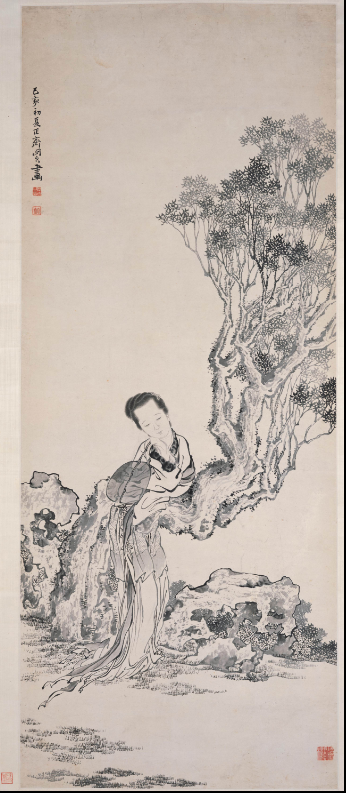| Lifestyle |
| Decoding contemporary China through ancient art | |
|
|
 A Lady Holding a Fan by Qing Dynasty (1644-1911) artist Min Zhen (SHANGHAI MUSEUM)
Chinese philosophy has produced a unique world of music, art and literature that never ceases to astonish audiences with its simplicity and tranquility, rendering Chinese art little known to the rest of the world—unfairly so. I worked in the arts for a long time before moving to China to continue my education and naïvely believed the country wouldn't have too many surprises in store for me. I'd planned to spend just a few hours at the Shanghai Museum when I first arrived, but as soon as I walked into the Chinese Painting Gallery, I completely lost track of time. I noticed a girl gazing on me from behind a glass frame and slowly found myself sinking deeper and deeper into the exhibit. A Lady Holding a Fan by Qing Dynasty (1644-1911) artist Min Zhen had caught my undivided attention. For a moment, her image perplexed me, as I had never witnessed such a subtle interaction between humanity and nature. Allow me to explain: Min's work depicts a young woman leaning against a tree, but its actual meaning runs much deeper. The closer you look, the more apparent it is that the girl's clothes and the tree's trunk and branches are all intertwined; over time, it becomes obvious that the girl and the tree are part of the same overarching piece. Chinese fine art has a vivid history and remarkable styles, flourishing over a period of 5,000 years. Today, art is not only a source of Chinese culture but also of its philosophy, history and perception of the world. I had the impression that each masterpiece in the Chinese Painting Gallery wanted to tell me a special story, an allegory of feelings associated with a rendezvous with nature. Min's work beautifully conveys the idea of the "shared nature" of all earthly beings. Unsurprisingly, China was the first country to put forth the idea of an ecological civilization—a society where people live in harmony with nature and respect it. We know little about the ancient Chinese scholars, as they understood the world in terms of holism and simultaneity rather than cause-and-effect relationships between its individual parts. This was a unique worldview and explanation of the way things are related to each other. This museum visit piqued my interest in China's ecological situation and environmental protection accomplishments. Several years back, the country announced its commitment to peaking carbon dioxide emissions before 2030 and achieving carbon neutrality before 2060. China is already a global leader in the production of renewable energy and is actively pursuing the replacement of fossil fuels and "greening" the industry. The fastest electric rail miles are in China, as are 98 percent of the world's electric buses. How China manages to maintain a synthesis between traditional culture and modern city life despite the rapid pace of modernization is particularly impressive. Seeing the environmental positive changes taking place in the country, I believe that several decades from now we will see technologically equipped and fully cultivated green cities, where people enjoy a reasonably prosperous way of life with a harmonious mindset and ecological awareness. After leaving the museum, something inside me began to change. As I slowly crossed the museum square, I unconsciously observed the blossoming flowers, children chasing snow white doves, the azure sky and a wonderful feeling of unity with the world. For the first time in a long time, I felt the urge to lean against a tree like the lady with the fan, rather than run off. To understand Chinese fine art, you need a flexible mind and a humble heart, but you don't have to be a prodigy; you only have to be willing to learn by feeling it, because this is about something no book will ever tell you. One has to experience it. And that is what the Chinese landscape offers you: It invites you to "talk" with its silence. (Print Edition Title: Peace of Mind) The author is a Russian student at East China Normal University in Shanghai Copyedited by Elsbeth van Paridon Comments to luyan@cicgamericas.com |
|
||||||||||||||||||||||||||||
|
